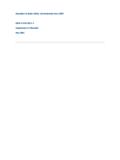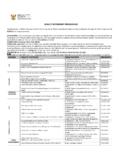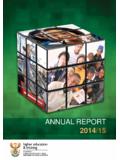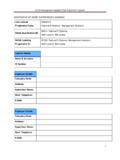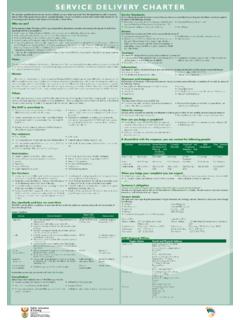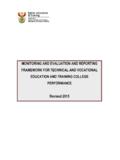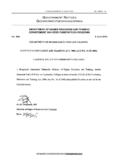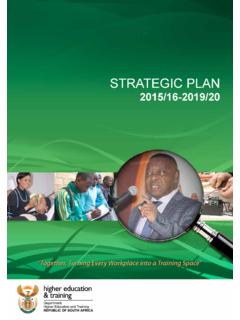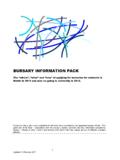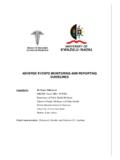Transcription of Fact Sheet - Adult Illiteracy iin South Africa[2]
1 MARCH 2021 FACT SHEETA dult Illiteracy in South AfricaAuthor: Mamphokhu Khuluvhe2 Department of Higher Education and Training 123 Francis Baard Street Pretoria South africa Private Bag X174 Pretoria 0001 Tel.: 0800 87 22 22 Department of Higher Education and Training The ideas, opinions, conclusions and policy recommendations expressed in this report are strictly those of the authors and do not necessarily represent those of the Department of Higher Education and Training (DHET). The DHET will not be liable for any incorrect data and for errors in conclusions, opinions and interpretations emanating from the information. Khuluvhe, M., (2021) Adult Illiteracy in South africa , Department of Higher Education and Training, Pretoria. This Fact Sheet is available on the Department of Higher Education and Training s website: Enquiries: Tel.: 012 312 5465 Fax: 086 457 0289 Email: Date of publication: March 2021 3 1.
2 BACKGROUND The United Nations Education, Science and Cultural Organisation (UNESCO) asserts that Literacy is an integral part of the right to education and the foundation of lifelong learning as well as a driver for sustainable development. It also postulates that literacy empowers individuals, improves livelihoods, enables greater participation in society and the labour market, benefits child and family health and nutrition, and reduces with inadequate levels of literacy cannot be fully involved in social and political discourse, but most importantly, cannot possibly make informed decisions that help shape policies in their communities. UNESCO also observes that beyond its conventional concept as a set of reading, writing and counting skills, literacy is now understood as a means of identification, understanding, interpretation, creation, and communication in an increasingly digital, text-mediated, information-rich and fast-changing at least 773 million youth and adults still cannot read and write and 250 million children are failing to acquire basic literacy skills.
3 This results in an exclusion of low-literate and low-skilled youth and adults from full participation in their communities and societies3. The United Nations takes the following approaches to promote literacy worldwide: Building strong foundations through early childhood care and education; Providing quality basic education for all children; Scaling-up functional literacy levels for youth and adults who lack basic literacy skills; and Developing literate environments. The White Paper on Post-School Education and Training4 (PSET) points out that the PSET system is expected to cater for adults who never attended school or who did not complete schooling. South africa also has international obligations to ensure the provision of education for all. Among these obligations are the United Nations Sustainable Development Goal 4 that calls for an inclusive and quality equitable education for all, and to ensure that all youth and a substantial proportion of adults, both men and women, achieve literacy and numeracy.
4 It is therefore imperative for the Department to understand the extent to which adults do not have the levels of education that could make them functionally literate, and to provide programmes that could deal with this challenge. 1 2 3 4 DHET. (2013). White Paper for Post-School Education and Training. Department of Higher Education and Training, Pretoria. 4 2. PURPOSE The purpose of this Fact Sheet is to show the extent to which there is potential demand for programmes that address the challenge of Adult Illiteracy in South africa . This Fact Sheet responds to the following questions: a) What is the Adult Illiteracy rate in South africa , and what are its patterns of distribution? b) What are the implications of the findings on Adult Illiteracy for the PSET system? 3. TERMS AND DEFINITIONS Literacy Literacy is the ability to identify, understand, interpret, create, communicate and compute, using printed and written materials associated with varying contexts5.
5 Literacy involves a continuum of learning in enabling individuals to achieve their goals, to develop their knowledge and potential, and to participate fully in their community and wider society. It measures adults proficiency in key information-processing skills such as literacy, numeracy and problem solving in technology-rich environments6. Functional literacy A person is functionally literate who can engage in all those activities in which literacy is required for effective functioning of his group and community and also for enabling him to continue to use reading, writing and calculation for his own and the community s development7. Functional Illiteracy A person is functionally illiterate who cannot engage in all those activities in which literacy is required for effective functioning of his group and community and also for enabling him to continue to use reading, writing and calculation for his own and the community s development8.
6 In South africa , the level of educational attainment is used as a proxy to measure literacy levels within the country, and Grade 7 not completed is used by both the Department of Basic Education9 and Statistics South Africa10 in terms of their General Housing Survey as a proxy measure for functional Illiteracy . This Fact Sheet therefore uses Grade 7 not completed as a proxy measure for functional Illiteracy . 5 6 7 8 9 Department of Basic Education. (2019). General Household Survey (GHS) 2018 report: Focus on schooling. Department of Basic Education, Pretoria. 10 Statistics South africa . (2020). General Household Survey 2019. 5 Adult Illiteracy Rate Adult Illiteracy rate is calculated by dividing the number of persons of a given age range who are not literate, by the corresponding age group population and multiply the result by 100. Adult Adult refers to persons aged 20 years and older in the South African population.
7 6 4. FACTS AND FIGURES In 2019, the South African Adult Illiteracy rate was 12%, reflecting a significant improvement of percentage points over the past decade. Despite this improvement, it is striking that million adults in South africa are still illiterate. South africa s Illiteracy rate is not far ahead of the global average of 14%11, and is therefore a matter of concern. Although Illiteracy levels are higher for females ( ) than males ( ), the gender gap in shares of Illiteracy as well as Illiteracy rates have narrowed markedly. Table 1: Number and percentage of persons in the population aged 20 and older who have not completed grade 7 and above by gender, 2009 and 2019 Gender 2009 2019 Number % Share Illiteracy rate Number % Share Illiteracy rate Male 2 480 923 2 046 127 Female 3 265 779 2 375 457 Total 5 746 702 4 421 584 Source: General Household Survey (GHS). Statistics South africa Table 2 shows that in 2019 the Illiteracy rate remained highest among Black Africans compared to other race groupings.
8 Of note though, is that the Illiteracy rate among Black Africans had declined significantly over the past 10 years, while that among Whites had actually increased, the latter probably due to age demographics. Table 2: Number and percentage of persons in the population aged 20 and above who have not completed grade 7 and above by population group, 2009 and 2019 Population Group 2009 2019 Number % Share Illiteracy rate Number % Share Illiteracy rate Black African 5 289 177 4 037 328 Coloured 399 305 336 637 Indian 46 704 35 502 White 11 516 12 117 Total 5 746 702 4 421 585 Source: General Household Survey (GHS). Statistics South africa 11 Adapted from UNESCO Institute of Statistics (Wikipedia) 7 Table 3 shows that in 2019, the highest Illiteracy rates are observed in Eastern Cape ( ) followed closely by North-West ( ) and Limpopo ( ). Although kwazulu - natal does not have the highest Illiteracy rate in South africa , it is home to the largest number of persons who are illiterate in South africa (980 000).
9 Eastern Cape (680 000) and Limpopo (582 000) follow on kwazulu - natal in respect of the numbers of people who are not literate. Given Gauteng s status as the richest province in South africa , it is surprising that its Illiteracy rate is above the national average, and that it has over half a million people who are not literate. Table 3: Number and percentage of persons in the population aged 20 and above who have not completed grade 7 and above by province, 2009 and 2019 Province 2009 2019 Number % Share Illiteracy rate Number % Share Illiteracy rate Western Cape 420 468 339 714 Eastern Cape 933 882 679 400 Northern Cape 184 852 123 974 Free State 346 782 271 106 kwazulu - natal 1 262 453 979 592 North West 552 925 437 751 Gauteng 772 837 579 664 Mpumalanga 514 700 428 023 Limpopo 757 802 582 361 Total 5 746 701 4 421 584 Source: General Household Survey (GHS).
10 Statistics South africa Table 4 shows that, as expected12, older adults13 in South africa are more likely to be illiterate than younger adults14. In 2019, the Illiteracy rate was highest amongst 60-64 years old ( ) followed by 55-59 years old ( ), while that among young adults was generally less than 6%. Interestingly, the Illiteracy rate for 15-19 year-olds ( ) was higher than that for 20-24 year-olds ( ). This observation could possibly be explained by younger people not yet having completed Grade 7 because of grade repetition at school. Nonetheless, this phenomenon does need further investigation. The share of adults who are illiterate increased significantly from 2009 to 2019 within the following age groups: 60-64 years old ( percentage points increase), 55-59 years old ( percentage points increase), 35-39 years old ( percentage point increase) and 30-34 years old ( percentage point increase). 12 Younger adults are likely to be more literate than older adults because over the past 25 years, access to education, especially schooling, has improved remarkably 13 Older adults refer to persons aged 35 to 64 years old.
